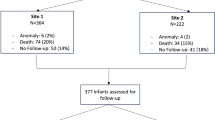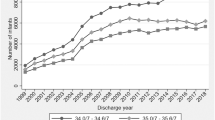Abstract
Objective:
The objective was to evaluate the postneonatal mortality rate at our institution from 1999 to 2006 as a follow-up to a previous report from our hospital covering 1993 to 1998 and to investigate the causes of death in infants dying in the postneonatal period.
Study Design:
We identified all infant deaths before discharge from the nursery aged ⩾28 days. Clinical data for all cases and autopsy records where available were reviewed and the cause of death was determined for each infant.
Result:
Total nursery deaths for the 7 years were 211, of which 14 (6.6%) occurred after the neonatal period. This represents a decreasing trend from the 12% reported in 1993 to 1998. Causes of death were the complications of prematurity and congenital defects. The five infants whose cause of death was the complications of prematurity had chronic lung disease, four had abdominal surgery for perforation and resection and two had intraventricular hemorrhage (IVH) Gr IV. All infants had multiple organ failure by the time of death and the final event was infection and/or renal failure. The nine congenital defects included two trisomy 21 with complications, one CHARGE association with heart defects, one hypertrophic cardiomyopathy and two others with multiple congenital heart defects. Of the three remaining infants, the anomalies included one with hydranencephaly, one with caudal regression and one with multiple vascular liver tumors.
Conclusion:
Along with the general decrease in infant mortality, postneonatal mortality is decreasing as a percentage of nursery deaths. The causes of death include complications of prematurity and congenital defects.
This is a preview of subscription content, access via your institution
Access options
Subscribe to this journal
Receive 12 print issues and online access
$259.00 per year
only $21.58 per issue
Buy this article
- Purchase on Springer Link
- Instant access to full article PDF
Prices may be subject to local taxes which are calculated during checkout
Similar content being viewed by others
References
Miniño A, Heron M, Murphy S, Kochanek K . Deaths: final data for 2004. Natl Vital Stat Rep 2007; 55: 1–16.
Robison NJ, Hodgman JE, Barton L, Pavlova Z . Causes of nursery death beyond the neonatal period. J Perinatol 2003; 23: 142–147.
Friede A, Rhodes PH, Guyer B, Binkin NJ, Hannan MT, Hogue CJR . The postponement of neonatal deaths into the postneonatal period: evidence from Massachusetts. Am J Epidemiol 1987; 127: 161–170.
Piper JM . Preventing and postponing death: trends in Tennessee infant mortality. Am J Public Health 1991; 81: 1046–1048.
Kim BI, Lee KS, Khoshnood B, Hseih HL, Chen TJ, Mittendorf R . Impact of increased neonatal survival on postneonatal mortality in the United States. Paediatr Perinat Epidemiol 1996; 10: 423–431.
Barton L, Hodgman JE . The contribution of withholding or withdrawing care to newborn mortality. Pediatrics 2005; 116: 1487–1491.
Hazebroek FWJ, Tibboel D, Mourik M, Bos AP, Molenaar JC . Withholding and withdrawal of life support from surgical neonates with life-threatening congenital anomalies. J Pediatr Surg 1993; 28: 1093–1097.
Lantos LD, Tyson JE, Allen A, Frader J, Hack M, Korones S et al. Withholding and withdrawing life-sustaining treatment in neonatal intensive care: issues for the 1990s. Arch Dis Childhood 1994; 71: F218–F223.
Wall SN, Partridge JC . Death in the intensive care nursery: physician practice of withdrawing and withholding life support care. Pediatrics 1997; 99: 64–70.
Wall SN, Partridge JC . Analgesia for dying infants whose life support is withdrawn or withheld. Pediatrics 1997; 99: 76–79.
Sweet MP, Hodgman JE, Pena I, Barton L, Pavlova Z, Ramanathan R . Two-year outcome of infants weighing 600 grams or less at birth and born 1994 through 1998. Obstet Gynecol 2003; 101: 18–23.
Yost CC, Soll RF . Early versus delayed selective surfactant treatment for neonatal respiratory distress syndrome. Cochrane Database Syst Rev 2006; (1): CD001456.
Halliday HL . Prevention strategies of chronic lung disease. Pediatr Pulmonol 2004; 26: 103–105.
Rich W, Finer NN, Vaucher YE . Ten-year trends in neonatal assisted ventilation of very low-birthweight infants. J Perinatol 2003; 23: 660–663.
Harper RG, Rehman KU, Sia C, Buckwald S, Spinazzola R, Schlessel J et al. Neonatal outcome of infants born at 500 to 800 grams from 1990 through 1998 in a tertiary care center. J Perinatol 2002; 22: 555–562.
Author information
Authors and Affiliations
Corresponding author
Rights and permissions
About this article
Cite this article
Turlington, A., Hodgman, J. & Barton, L. Decreasing trend in postneonatal mortality. J Perinatol 28, 188–191 (2008). https://doi.org/10.1038/sj.jp.7211910
Received:
Revised:
Accepted:
Published:
Issue Date:
DOI: https://doi.org/10.1038/sj.jp.7211910



